NMR Data Acquisition The process of data acquisition results in an ...
NMR Data Acquisition The process of data acquisition results in an ...
NMR Data Acquisition The process of data acquisition results in an ...
You also want an ePaper? Increase the reach of your titles
YUMPU automatically turns print PDFs into web optimized ePapers that Google loves.
<strong>NMR</strong> <strong>Data</strong> <strong>Acquisition</strong><br />
<strong>The</strong> <strong>process</strong> <strong>of</strong> <strong>data</strong> <strong>acquisition</strong> <strong>results</strong> <strong>in</strong> <strong>an</strong> FID signal resid<strong>in</strong>g <strong>in</strong> the computer <strong>of</strong> the<br />
<strong>NMR</strong> <strong>in</strong>strument. In order to properly set up the <strong>acquisition</strong> parameters, it is helpful to<br />
underst<strong>an</strong>d a little about how this is accomplished. <strong>The</strong> sequence <strong>of</strong> events <strong>in</strong>volved <strong>in</strong> the<br />
<strong>acquisition</strong> <strong>of</strong> the raw <strong>data</strong> for a simple 1D 1 H spectrum on a 200 MHz <strong>in</strong>strument is as follows<br />
(Fig. 6):<br />
1. Wait a period <strong>of</strong> time called the Relaxation Delay for sp<strong>in</strong>s to reach thermal<br />
equilibrium<br />
2. Send a high-power short-duration radio frequency (200 MHz) pulse to the probe coil<br />
3. Receive the result<strong>in</strong>g free <strong>in</strong>duction decay (FID) signal from the probe coil<br />
4. Amplify this weak RF (~200 MHz) signal<br />
5. Convert the RF (MHz) signal to a “stereo” audio (kHz) signal<br />
6. Sample the audio (<strong>an</strong>alog) signal at regular <strong>in</strong>tervals <strong>an</strong>d convert it to a list <strong>of</strong> <strong>in</strong>tegers<br />
7. Add the digital FID “list” to a sum FID <strong>in</strong> memory<br />
8. Repeat steps 1-8 for as m<strong>an</strong>y “sc<strong>an</strong>s” or “tr<strong>an</strong>sients” as desired<br />
20<br />
Figure 6. <strong>The</strong> precess<strong>in</strong>g nuclei <strong>in</strong> the<br />
sample <strong>in</strong>duce the radio frequency FID<br />
signal <strong>in</strong> the coil <strong>of</strong> the probe. This signal is<br />
amplified <strong>an</strong>d mixed with two reference RF<br />
signals at the detector. <strong>The</strong> reference signal<br />
frequency determ<strong>in</strong>es the center <strong>of</strong> the<br />
spectral w<strong>in</strong>dow. One reference signal is<br />
shifted <strong>in</strong> phase by 90 o from the other. <strong>The</strong><br />
result <strong>of</strong> the mix<strong>in</strong>g step is <strong>an</strong> audio<br />
frequency which is the difference between<br />
the FID frequency <strong>an</strong>d the reference<br />
frequency. This audio frequency c<strong>an</strong> be<br />
either positive (downfield <strong>of</strong> the center <strong>of</strong> the<br />
spectral w<strong>in</strong>dow) or negative (upfield).<br />
<strong>The</strong>re are actually two audio signals, which<br />
are called the "real" <strong>an</strong>d the "imag<strong>in</strong>ary"<br />
parts <strong>of</strong> the FID, result<strong>in</strong>g from mix<strong>in</strong>g with<br />
either a 0 o or a 90 o reference frequency.<br />
<strong>The</strong> <strong>an</strong>alog-to-digital (ADC) converter<br />
samples these FIDs at regular <strong>in</strong>tervals <strong>an</strong>d<br />
sends a list <strong>of</strong> numbers to the Sum-To-<br />
Memory, which adds them to the runn<strong>in</strong>g<br />
sum <strong>of</strong> FIDs. When all sc<strong>an</strong>s are f<strong>in</strong>ished,<br />
this sum is stored <strong>in</strong> the computer as the FID.<br />
Each <strong>of</strong> these steps will be<br />
discussed <strong>in</strong> more detail, with the<br />
goal <strong>of</strong> underst<strong>an</strong>d<strong>in</strong>g the basic<br />
parameters needed to set up <strong>an</strong> <strong>NMR</strong><br />
experiment. <strong>The</strong> FID conta<strong>in</strong>s all <strong>of</strong> the frequencies <strong>of</strong> the sample protons, which represent a
<strong>an</strong>ge <strong>of</strong> chemical shift values. <strong>The</strong> r<strong>an</strong>ge <strong>of</strong> radio frequencies <strong>in</strong> the FID is extremely narrow:<br />
199.999 MHz to 200.001 MHz for a 10 ppm r<strong>an</strong>ge <strong>of</strong> chemical shifts. We are only <strong>in</strong>terested <strong>in</strong><br />
this t<strong>in</strong>y slice <strong>of</strong> frequencies, so it is convenient to subtract out the fundamental frequency<br />
(200.000 MHz) <strong>an</strong>d look only at the differences, r<strong>an</strong>g<strong>in</strong>g from -0.001 MHz to +0.001 MHz, or<br />
from - 1.000 kHz to +1.000 kHz. <strong>The</strong>se much lower frequencies are called “audio” frequencies,<br />
s<strong>in</strong>ce they are <strong>in</strong> the r<strong>an</strong>ge <strong>of</strong> sound waves which c<strong>an</strong> be detected by the hum<strong>an</strong> ear. In fact, the<br />
audio signal <strong>of</strong> <strong>an</strong> <strong>NMR</strong> c<strong>an</strong> be connected to a pair <strong>of</strong> speakers so you c<strong>an</strong> listen to the FID <strong>in</strong><br />
stereo!<br />
This subtraction <strong>of</strong> frequencies is accomplished by <strong>an</strong> electronic <strong>process</strong> called “mix<strong>in</strong>g”.<br />
It actually <strong>in</strong>volves multiplication <strong>of</strong> the FID signal with a reference frequency signal (200.000<br />
MHz <strong>in</strong> this example), with the result<strong>in</strong>g signal hav<strong>in</strong>g frequency components represent<strong>in</strong>g both<br />
the sum <strong>an</strong>d the difference <strong>of</strong> the FID frequency <strong>an</strong>d the reference frequency.<br />
199.999 - 200.001 MHz r<strong>an</strong>ge X 200.000 MHz reference =<br />
-1.000 kHz to +1.000 kHz 399.999 - 400.001 MHz<br />
difference<br />
sum<br />
<strong>The</strong> sum is elim<strong>in</strong>ated by <strong>an</strong> electronic filter, leav<strong>in</strong>g only the desired audio signal. In case <strong>an</strong>y <strong>of</strong><br />
you are wonder<strong>in</strong>g about this bit <strong>of</strong> electronic magic, it c<strong>an</strong> be expla<strong>in</strong>ed by high school<br />
trigonometry as follows:<br />
s<strong>in</strong>(αt)cos(βt) = 1/2 {[s<strong>in</strong>(αt)cos(βt) + s<strong>in</strong>(βt)cos(αt)] + [s<strong>in</strong>(αt)cos(-βt) + s<strong>in</strong>(-βt)cos(αt)]}<br />
= 1/2 { [s<strong>in</strong>((α+β)t)] + [s<strong>in</strong>((α-β)t)] }<br />
This just says that the product <strong>of</strong> two waves <strong>of</strong> different frequency α <strong>an</strong>d β is that same as the sum<br />
<strong>of</strong> two waves <strong>of</strong> frequency α+β (sum) <strong>an</strong>d α-β (difference).<br />
<strong>The</strong> audio signals must be converted <strong>in</strong>to a list <strong>of</strong> numbers, which is the only l<strong>an</strong>guage<br />
that a computer underst<strong>an</strong>ds. This is done by sampl<strong>in</strong>g the voltage <strong>of</strong> each signal at regular<br />
<strong>in</strong>tervals <strong>of</strong> time <strong>an</strong>d convert<strong>in</strong>g each <strong>an</strong>alog voltage level <strong>in</strong>to <strong>an</strong> <strong>in</strong>teger number. Thus <strong>an</strong> FID<br />
becomes a long list <strong>of</strong> numbers, which is stored <strong>in</strong> the computer memory. As the same FID is<br />
acquired over <strong>an</strong>d over aga<strong>in</strong>, repeat<strong>in</strong>g the sequence: relaxation delay, pulse, acquire FID, each<br />
new list <strong>of</strong> numbers is added to the list stored <strong>in</strong> memory. This <strong>process</strong> is called “sum to<br />
memory”. As more <strong>an</strong>d more “sc<strong>an</strong>s” or “tr<strong>an</strong>sients” are acquired, the signal-to-noise ratio <strong>of</strong><br />
this sum improves. Now let’s look <strong>in</strong> detail at each <strong>process</strong>, so we c<strong>an</strong> underst<strong>an</strong>d the <strong>NMR</strong><br />
<strong>acquisition</strong> parameters.<br />
1. Relaxation Delay: D1 (Vari<strong>an</strong>) or RD (Bruker). Usually the <strong>acquisition</strong> (Pulse-FID)<br />
is repeated a number <strong>of</strong> times <strong>in</strong> order to sum the <strong>in</strong>dividual FIDs <strong>an</strong>d <strong>in</strong>crease the signal-to-noise<br />
ratio. In this case a delay must be <strong>in</strong>serted before each pulse-FID sequence to allow the<br />
populations to return to a Boltzm<strong>an</strong>n distribution (“relaxation”). Without this delay the nuclei<br />
will become saturated (equal populations <strong>in</strong> the two energy levels) <strong>an</strong>d there will be little or no<br />
signal <strong>in</strong> each FID. Ideally, you should wait about five times the characteristic relaxation time<br />
(T 1 ) before start<strong>in</strong>g the next pulse, but <strong>in</strong> practice the relaxation delay is quite a bit less <strong>an</strong>d you<br />
live with a certa<strong>in</strong> reduction <strong>of</strong> signal. This is a compromise value because puls<strong>in</strong>g more <strong>of</strong>ten<br />
gives you more <strong>data</strong> per unit time. In this case, you rapidly reach a steady state where the nuclei<br />
21
are not completely relaxed but are at least at the same degree <strong>of</strong> relaxation each time a new pulse<br />
arrives. Relaxation is go<strong>in</strong>g on dur<strong>in</strong>g the FID <strong>acquisition</strong> period as well, <strong>an</strong>d sometimes with<br />
long <strong>acquisition</strong> times there is no need for a specific relaxation delay. Another strategy for slowrelax<strong>in</strong>g<br />
nuclei (e.g., quaternary carbons <strong>in</strong> 13 C-<strong>NMR</strong>) is to reduce the pulse width so that the<br />
perturbation from equilibrium result<strong>in</strong>g from each pulse is reduced.<br />
2. <strong>The</strong> Pulse (PW). <strong>The</strong> RF pulse is simply a high-power RF signal turned on for a<br />
very short period <strong>of</strong> time, on the order <strong>of</strong> microseconds (µs). <strong>The</strong> duration <strong>of</strong> the RF pulse <strong>in</strong><br />
microseconds is called the Pulse Width (PW, Fig. 7). <strong>The</strong> frequency <strong>of</strong> the pulse is set at the<br />
center <strong>of</strong> the spectral w<strong>in</strong>dow (r<strong>an</strong>ge <strong>of</strong> reson<strong>an</strong>t frequencies expected), but because <strong>of</strong> its short<br />
duration it is capable <strong>of</strong> excit<strong>in</strong>g all <strong>of</strong> the sample nuclei with<strong>in</strong> the spectral w<strong>in</strong>dow<br />
simult<strong>an</strong>eously. Us<strong>in</strong>g our example <strong>of</strong> a 200 MHz 1 H experiment, the pulse frequency would be<br />
200.000 MHz but all nuclei resonat<strong>in</strong>g <strong>in</strong> the r<strong>an</strong>ge 199.999 to 200.001 MHz would be equally<br />
excited by it. <strong>The</strong> pulse shape is rect<strong>an</strong>gular, me<strong>an</strong><strong>in</strong>g that the RF power turns on more or less<br />
<strong>in</strong>st<strong>an</strong>t<strong>an</strong>eously to full power, <strong>an</strong>d then PW microseconds later turns <strong>of</strong>f. A “90 degree pulse” is<br />
the pulse width required to exactly tip the sample magnetization from the z-axis <strong>in</strong>to the x-y<br />
pl<strong>an</strong>e (Fig. 7), where it rotates at the reson<strong>an</strong>t frequency <strong>in</strong> the x-y pl<strong>an</strong>e, lead<strong>in</strong>g to a maximum<br />
Figure 7. <strong>The</strong> pulse width (PW) is the duration <strong>of</strong> the<br />
excitation pulse <strong>in</strong> microseconds. <strong>The</strong> pulse is a high<br />
power RF signal which is turned on <strong>an</strong>d then after PW<br />
microseconds turned <strong>of</strong>f. <strong>The</strong> sample magnetization,<br />
which is on the Z axis at equilibrium, is rotated about the<br />
X axis by the excitation pulse. A "90 degree pulse" is the<br />
length <strong>of</strong> time it takes to rotate the magnetization to the -<br />
Y axis. Longer pulses will cont<strong>in</strong>ue rotat<strong>in</strong>g to the -Z<br />
axis (180 o pulse) <strong>an</strong>d to the +Y axis (270 o pulse).<br />
<strong>in</strong>tensity FID signal. <strong>The</strong> sample magnetization<br />
is just the sum <strong>of</strong> all the <strong>in</strong>dividual nuclear<br />
magnets. <strong>The</strong> length <strong>of</strong> the 90 degree pulse<br />
depends on the RF power, <strong>an</strong>d to some extent<br />
on the probe <strong>an</strong>d the sample. For some<br />
experiments, calibration <strong>of</strong> the 90 degree pulse<br />
width is essential for the experiment to work<br />
right. For simple one-pulse experiments <strong>an</strong><br />
approximate value is sufficient. In more<br />
sophisticated experiments which use more th<strong>an</strong><br />
one pulse separated by various time delays, the pulse duration parameters are P1, P2, P3, etc. for<br />
the various pulses <strong>in</strong> the sequence. Pulses are always entered <strong>in</strong> microseconds (µs) <strong>an</strong>d should<br />
not be made very long (more th<strong>an</strong> a few hundred µs) because at full power the amplifiers c<strong>an</strong><br />
"burn up" if left on cont<strong>in</strong>uously for too long.<br />
3. Receiv<strong>in</strong>g the FID from the sample. As the sample magnetization rotates <strong>in</strong> the x-y<br />
pl<strong>an</strong>e, the same probe coil which tr<strong>an</strong>smitted the high-power RF pulse to the sample experiences<br />
a very weak <strong>in</strong>duced signal. This signal decays to noth<strong>in</strong>g over a period <strong>of</strong> a second or two, <strong>an</strong>d<br />
the full time course <strong>of</strong> this <strong>in</strong>duced signal is called the Free Induction Decay, or FID. Each type<br />
22
<strong>of</strong> nucleus <strong>in</strong> the molecule (e.g., the CH 3 , CH 2 <strong>an</strong>d OH protons <strong>in</strong> eth<strong>an</strong>ol) has its own reson<strong>an</strong>t<br />
frequency, so the FID consists <strong>of</strong> a superposition <strong>of</strong> a number <strong>of</strong> pure frequencies, correspond<strong>in</strong>g<br />
to a number <strong>of</strong> peaks <strong>in</strong> the spectrum. All <strong>of</strong> the <strong>in</strong>formation <strong>of</strong> the <strong>NMR</strong> spectrum is conta<strong>in</strong>ed<br />
<strong>in</strong> the FID, <strong>an</strong>d a large part <strong>of</strong> the spectrometer is devoted to amplify<strong>in</strong>g, record<strong>in</strong>g <strong>an</strong>d <strong>an</strong>alyz<strong>in</strong>g<br />
this signal.<br />
4. <strong>The</strong> Receiver amplifies the radio frequency FID signal com<strong>in</strong>g from the probe,<br />
converts it to <strong>an</strong> audio frequency signal by subtract<strong>in</strong>g out the radio frequency at the center <strong>of</strong> the<br />
spectral w<strong>in</strong>dow, amplifies it some more, <strong>an</strong>d then converts it to a list <strong>of</strong> numbers. <strong>The</strong> total<br />
amplification given to the FID <strong>in</strong> the receiver is called the Receiver Ga<strong>in</strong> (Vari<strong>an</strong>: GAIN or<br />
Bruker: RG). <strong>The</strong> <strong>in</strong>tensity <strong>of</strong> the FID signal <strong>in</strong>duced <strong>in</strong> the probe coil depends on the sample<br />
concentration, so the amount <strong>of</strong> ga<strong>in</strong> or amplification <strong>in</strong> the receiver must be adjusted for each<br />
new sample. <strong>The</strong> audio signal com<strong>in</strong>g <strong>in</strong>to the digitization stage (the <strong>an</strong>alog-to-digital converter<br />
or ADC) should ideally be <strong>of</strong> the same magnitude for all samples, regardless <strong>of</strong> concentration.<br />
<strong>The</strong> ADC has a maximum r<strong>an</strong>ge <strong>of</strong> <strong>in</strong>teger values that it c<strong>an</strong> give to the signal as it comes <strong>in</strong>,<br />
usually -32,767 to 32,768 (Fig. 8). If the signal is amplified too little before digitization,<br />
the<br />
Figure 8. <strong>The</strong> ADC ("digitizer") c<strong>an</strong> be<br />
viewed as a ladder <strong>of</strong> possible numerical<br />
values. In the figure <strong>in</strong>teger values <strong>of</strong> -<br />
13 to +13 are shown, but <strong>in</strong> reality the<br />
r<strong>an</strong>ge is usually more like -32767 to<br />
+32768. If the ga<strong>in</strong> is set too high, the<br />
first portion <strong>of</strong> the FID has <strong>an</strong> <strong>an</strong>alog<br />
voltage higher th<strong>an</strong> the maximum <strong>of</strong> the<br />
digitizer, so these values are "clipped" at<br />
the maximum value. This will lead to<br />
large basel<strong>in</strong>e rolls <strong>in</strong> the spectrum. <strong>The</strong><br />
optimal ga<strong>in</strong> just fills the digitizer with<br />
signal without exceed<strong>in</strong>g the limits. If<br />
the ga<strong>in</strong> is set too low, the shape <strong>of</strong> the<br />
signal is lost <strong>an</strong>d a “blocky”<br />
representation <strong>results</strong>. This reduces<br />
signal-to-noise ratio <strong>an</strong>d dynamic r<strong>an</strong>ge.<br />
numbers will get "gra<strong>in</strong>y": they<br />
might r<strong>an</strong>ge from -7 to +8 with<br />
only 16 possible values. In this<br />
case it would be very difficult to<br />
f<strong>in</strong>d a small peak <strong>in</strong> the spectrum<br />
<strong>in</strong> the presence <strong>of</strong> big ones (<strong>in</strong><br />
f<strong>an</strong>cy l<strong>in</strong>go, this is called a<br />
"dynamic r<strong>an</strong>ge" limitation). If, on the other h<strong>an</strong>d, if the signal is amplified too much, it might<br />
exceed the digitizer limits <strong>an</strong>d get truncated or "cut <strong>of</strong>f". For example, a signal which would give<br />
a value <strong>of</strong> 52,314 would be read as 32,768 because the digitizer c<strong>an</strong>'t respond to <strong>an</strong>y larger value.<br />
This cutt<strong>in</strong>g <strong>of</strong>f or "clipp<strong>in</strong>g" has very drastic effects on the spectrum: the basel<strong>in</strong>e gets huge<br />
23
oscillations ("wiggles") which c<strong>an</strong>'t be corrected <strong>in</strong> <strong>an</strong>y way. So it's clear that the receiver ga<strong>in</strong><br />
has to be set correctly for each sample to get the best <strong>results</strong>. More concentrated samples (or<br />
samples with large solvent peaks) will require smaller receiver ga<strong>in</strong> values, while dilute samples<br />
are best run with large ga<strong>in</strong>. Both Vari<strong>an</strong> <strong>an</strong>d Bruker allow for <strong>an</strong> automatic receiver ga<strong>in</strong><br />
adjustment. On the Vari<strong>an</strong>, simply set GAIN to 'N'(not used) <strong>an</strong>d start the <strong>acquisition</strong>; a number<br />
<strong>of</strong> trial FIDs will be recorded to determ<strong>in</strong>e the best ga<strong>in</strong> value <strong>an</strong>d then the <strong>acquisition</strong> will beg<strong>in</strong>.<br />
On the Bruker, the comm<strong>an</strong>d RGA (receiver ga<strong>in</strong> adjust) will do the same th<strong>in</strong>g but will not<br />
automatically start <strong>acquisition</strong>.<br />
5. <strong>The</strong> Detector converts the RF FID signal <strong>in</strong>to <strong>an</strong> audio frequency FID signal by<br />
mix<strong>in</strong>g it with a reference RF signal which has a s<strong>in</strong>gle pure frequency at the center <strong>of</strong> the<br />
spectral w<strong>in</strong>dow. <strong>The</strong> result<strong>in</strong>g audio signal has frequencies which represent the difference<br />
between the actual reson<strong>an</strong>t frequencies <strong>of</strong> the sample nuclei <strong>an</strong>d the reference frequency. This<br />
me<strong>an</strong>s that the audio frequency at the center <strong>of</strong> the spectral w<strong>in</strong>dow is zero (reference freq. m<strong>in</strong>us<br />
reference freq.); the downfield half <strong>of</strong> the spectrum represents positive audio frequencies <strong>an</strong>d the<br />
upfield half represents negative audio frequencies. This corresponds to rotat<strong>in</strong>g the coord<strong>in</strong>ate<br />
system used to represent the sample magnetization about the z (vertical) axis at the reference<br />
frequency. In this rotat<strong>in</strong>g frame <strong>of</strong> reference, a nucleus which resonates at the reference<br />
frequency would have its magnetization st<strong>an</strong>d still <strong>in</strong> the x-y pl<strong>an</strong>e after the pulse. Nuclei which<br />
resonate <strong>in</strong> the downfield half <strong>of</strong> the spectral w<strong>in</strong>dow have their magnetization rotate counterclockwise<br />
<strong>in</strong> the x-y pl<strong>an</strong>e after the pulse, <strong>an</strong>d those which resonate <strong>in</strong> the upfield half give rise to<br />
magnetization which rotates clockwise <strong>in</strong> the rotat<strong>in</strong>g frame <strong>of</strong> reference (Fig. 9). Plac<strong>in</strong>g the<br />
zero <strong>of</strong> our audio<br />
24
Figure 9. Relative to the reference frequency<br />
(center <strong>of</strong> the spectral w<strong>in</strong>dow) the nuclei c<strong>an</strong><br />
rotate either clockwise or counter-clockwise <strong>in</strong><br />
the rotat<strong>in</strong>g frame <strong>of</strong> reference. Imag<strong>in</strong>e that we<br />
have a detector mounted on the x <strong>an</strong>d y axes,<br />
<strong>an</strong>d each time the magnet <strong>of</strong> the sample nuclei<br />
passes a detector it gives a "blip" from that<br />
detector. Clockwise rotation would give a<br />
pattern <strong>of</strong> blips where the y signal leads the x<br />
signal, while counter-clockwise rotation leads to<br />
a situation where the y signals lags beh<strong>in</strong>d the x<br />
signal. This is sufficient <strong>in</strong>formation to tell the<br />
direction <strong>of</strong> rotation, which is equivalent to the<br />
sign <strong>of</strong> the signal frequency. Thus the r<strong>an</strong>ge <strong>of</strong><br />
detectable frequencies is from -SW/2 to +SW/2.<br />
frequency scale <strong>in</strong> the center <strong>of</strong> the<br />
spectral w<strong>in</strong>dow requires that we have a<br />
way to tell the difference between<br />
positive frequencies <strong>an</strong>d negative<br />
frequencies. This is accomplished by<br />
us<strong>in</strong>g a technique called quadrature<br />
detection. <strong>The</strong> radio frequency FID<br />
signal is mixed with two different<br />
reference RF signals, one <strong>of</strong> which is<br />
shifted by 90 o (one-fourth <strong>of</strong> a cycle) <strong>in</strong> phase with respect to the other (Fig. 6). <strong>The</strong> difference<br />
frequency is selected <strong>in</strong> both cases, result<strong>in</strong>g <strong>in</strong> two audio signals which are 90 o out <strong>of</strong> phase with<br />
each other. <strong>The</strong>se signals are traditionally called the “real” <strong>an</strong>d the “imag<strong>in</strong>ary” FIDs, but there<br />
is noth<strong>in</strong>g more or less real about either one. <strong>The</strong> best way to th<strong>in</strong>k about these “stereo” signals<br />
is to imag<strong>in</strong>e that there are two coils <strong>in</strong> the spectrometer: one placed on the x axis <strong>of</strong> the rotat<strong>in</strong>g<br />
frame <strong>an</strong>d one placed on the y axis <strong>of</strong> the rotat<strong>in</strong>g frame. If the magnetization result<strong>in</strong>g from a<br />
type <strong>of</strong> nucleus <strong>in</strong> the sample is rotat<strong>in</strong>g clockwise <strong>in</strong> the rotat<strong>in</strong>g frame, it will generate a signal<br />
<strong>in</strong> the y-axis detector just before it hits the x-axis detector, so that the “imag<strong>in</strong>ary” (y-axis) signal<br />
will lag beh<strong>in</strong>d the “real” (x-axis) signal by 90 o (Figure 9). We c<strong>an</strong> thus determ<strong>in</strong>e that this<br />
frequency is a negative audio frequency, <strong>an</strong>d place the peak <strong>in</strong> the spectrum <strong>in</strong> the upfield half <strong>of</strong><br />
the spectral w<strong>in</strong>dow. Imag<strong>in</strong>e a carrousel with one person rid<strong>in</strong>g on it near the edge. If you have<br />
two observers, one on the north side <strong>an</strong>d one on the east side, <strong>an</strong>d each observer calls out the<br />
direction as the rider goes by, you c<strong>an</strong> tell which way the carrousel is rotat<strong>in</strong>g because you would<br />
hear “North East ... ... North East ... ...” for the clockwise direction <strong>an</strong>d “East North ...<br />
... East North ... ...” for the counter-clockwise direction. With only one observer you would<br />
hear, for example, “North ... ... ... North ... ... ...” <strong>an</strong>d you would not be able to tell which<br />
direction the carrousel is rotat<strong>in</strong>g. <strong>The</strong> direction <strong>of</strong> rotation <strong>of</strong> the carrousel is <strong>an</strong>alogous to the<br />
sign <strong>of</strong> the frequency <strong>of</strong> <strong>an</strong> <strong>NMR</strong> peak <strong>in</strong> your spectrum. If we only had one “detector”, which is<br />
the equivalent <strong>of</strong> hav<strong>in</strong>g only one FID ch<strong>an</strong>nel, we could not dist<strong>in</strong>guish between positive <strong>an</strong>d<br />
negative audio frequencies.<br />
25
6. <strong>The</strong> Analog-to-Digital Converter (ADC). <strong>The</strong> computer c<strong>an</strong>not underst<strong>an</strong>d<br />
<strong>an</strong>yth<strong>in</strong>g but numbers. <strong>The</strong> audio frequency FID is a cont<strong>in</strong>uous, smooth function <strong>of</strong> voltage<br />
(electrical <strong>in</strong>tensity) vs. time. <strong>The</strong> <strong>an</strong>alogto-digital<br />
converter (ADC or digitizer)<br />
samples the FID voltage at regular <strong>in</strong>tervals<br />
<strong>of</strong> time <strong>an</strong>d assigns <strong>an</strong> <strong>in</strong>teger value<br />
(positive or negative) to the <strong>in</strong>tensity at each<br />
sample time (Fig. 10). <strong>The</strong>se numbers go<br />
<strong>in</strong>to a cont<strong>in</strong>uous list <strong>of</strong> numbers that<br />
constitute<br />
Figure 10. Digital sampl<strong>in</strong>g <strong>of</strong> the FID leads to a list<br />
<strong>of</strong> positive <strong>an</strong>d negative <strong>in</strong>tegers which describes the<br />
signal. Sampl<strong>in</strong>g occurs very rapidly <strong>an</strong>d at a<br />
predeterm<strong>in</strong>ed <strong>in</strong>terval called the dwell time. In this<br />
example the dwell time was chosen to be 0.016<br />
seconds or 16 ms. Because the values are assigned<br />
to <strong>in</strong>tegers, the <strong>an</strong>alog <strong>in</strong>tensities are rounded to the<br />
nearest <strong>in</strong>teger at each sample.<br />
the digital FID. <strong>The</strong> spectrometer does not<br />
actually just acquire a s<strong>in</strong>gle value for each<br />
time po<strong>in</strong>t - it's more like a stereo receiver.<br />
<strong>The</strong>re are two ch<strong>an</strong>nels <strong>in</strong> the receiver, one<br />
which effectively records signals along the<br />
“x” axis <strong>of</strong> the rotat<strong>in</strong>g frame <strong>an</strong>d one which<br />
records signals along the “y” axis (Fig. 6).<br />
<strong>The</strong>se are usually referred to as the “real”<br />
<strong>an</strong>d “imag<strong>in</strong>ary” parts <strong>of</strong> the signal, but this<br />
is just a mathematical convenience <strong>an</strong>d<br />
doesn't imply that one ch<strong>an</strong>nel is more real th<strong>an</strong> the other. So the list <strong>of</strong> numbers is really twice<br />
as long because both FIDs are sampled by the ADC, <strong>an</strong>d the numbers are loaded <strong>in</strong>to the list <strong>in</strong><br />
pairs: real(1), imag.(1), real(2), imag.(2), ..., etc. Bruker <strong>an</strong>d Vari<strong>an</strong> have different ways <strong>of</strong><br />
sampl<strong>in</strong>g, which leads to some differences <strong>in</strong> <strong>process</strong><strong>in</strong>g <strong>an</strong>d <strong>in</strong>terpretation <strong>of</strong> <strong>data</strong>. Vari<strong>an</strong><br />
samples the two FIDs simult<strong>an</strong>eously at each time value, <strong>an</strong>d Bruker alternates between real <strong>an</strong>d<br />
imag<strong>in</strong>ary samples <strong>in</strong> time; for example:<br />
Vari<strong>an</strong><br />
(simult<strong>an</strong>eous)<br />
Bruker<br />
(alternate)<br />
Time (µs) Real Imag<strong>in</strong>ary Real Imag<strong>in</strong>ary<br />
0 1. 23435 2. -2344 1. 13465<br />
80 2. 9354<br />
160 3. 6509 4. 3496 3. -3546<br />
240 4. 31593<br />
320 5. 5673 6. -234 5. 23486<br />
26
400 6. -14367<br />
Note that <strong>in</strong> 2D <strong>NMR</strong> the sampl<strong>in</strong>g <strong>in</strong> the second dimension c<strong>an</strong> also be done either way,<br />
except that this choice is up to the user <strong>an</strong>d is not “hard wired”. <strong>The</strong> alternate (“Bruker-like”)<br />
sampl<strong>in</strong>g method is called “TPPI” (for Time Proportional Phase Incrementation) <strong>an</strong>d the<br />
simult<strong>an</strong>eous (“Vari<strong>an</strong>-like”) method is called “States” or “States-Haberkorn” (after the orig<strong>in</strong>ators<br />
<strong>of</strong> the technique). <strong>The</strong> consequences for <strong>process</strong><strong>in</strong>g <strong>an</strong>d <strong>in</strong>terpretation <strong>of</strong> the <strong>data</strong> are the same <strong>in</strong><br />
the second dimension as they are <strong>in</strong> 1D <strong>NMR</strong>.<br />
This leads to confusion over two parameters: the number <strong>of</strong> po<strong>in</strong>ts collected (do you me<strong>an</strong> the<br />
total number <strong>of</strong> <strong>data</strong> po<strong>in</strong>ts, or the number <strong>of</strong> real / imag<strong>in</strong>ary pairs?) <strong>an</strong>d the time spac<strong>in</strong>g<br />
between <strong>data</strong> po<strong>in</strong>ts. Both Bruker <strong>an</strong>d Vari<strong>an</strong> list the number <strong>of</strong> <strong>data</strong> po<strong>in</strong>ts (Vari<strong>an</strong>: NP, Bruker:<br />
TD) as the total number <strong>of</strong> po<strong>in</strong>ts, count<strong>in</strong>g both real <strong>an</strong>d imag<strong>in</strong>ary. Some <strong>in</strong>dependent <strong>NMR</strong><br />
s<strong>of</strong>tware packages (e.g., Felix) count po<strong>in</strong>ts as “complex pairs”: one “po<strong>in</strong>t” corresponds to one<br />
pair <strong>of</strong> numbers (real <strong>an</strong>d imag<strong>in</strong>ary). <strong>The</strong> time spac<strong>in</strong>g between successive <strong>data</strong> po<strong>in</strong>ts sampled<br />
<strong>in</strong> the FID is called the dwell time (Bruker: DW). In the above example, the dwell time is clearly<br />
equal to 80 µs between samples for the Bruker <strong>data</strong>, but <strong>in</strong> the Vari<strong>an</strong> case we need to th<strong>in</strong>k <strong>of</strong><br />
the dwell time as the average time per sample, which is still 80 µs because two samples are<br />
collected <strong>in</strong> a period <strong>of</strong> 160 µs. Vari<strong>an</strong> does not have a parameter correspond<strong>in</strong>g to dwell time,<br />
leav<strong>in</strong>g the sampl<strong>in</strong>g <strong>process</strong> hidden from the user. <strong>The</strong> two types <strong>of</strong> <strong>data</strong> (alternate <strong>an</strong>d<br />
simult<strong>an</strong>eous) must be <strong>process</strong>ed by a different Fourier tr<strong>an</strong>sform method, but this is tr<strong>an</strong>sparent<br />
as long as you <strong>process</strong> the <strong>data</strong> on the <strong>in</strong>strument which acquired it. If you tr<strong>an</strong>sfer the <strong>data</strong> to a<br />
computer <strong>an</strong>d use “third party” s<strong>of</strong>tware (e.g., Felix) to <strong>process</strong> it, you need to choose the correct<br />
Fourier tr<strong>an</strong>sform method for the type <strong>of</strong> FID <strong>data</strong> be<strong>in</strong>g <strong>process</strong>ed.<br />
How rapidly do we need to sample the <strong>data</strong>? Clearly this is limited by how fast the<br />
hardware c<strong>an</strong> convert <strong>an</strong>alog to digital, but <strong>in</strong> most cases this limitation is not serious. It turns<br />
out that the rate <strong>of</strong> sampl<strong>in</strong>g is determ<strong>in</strong>ed by the highest frequency signal you need to describe<br />
by the digitized <strong>data</strong>. In other words, what peak <strong>in</strong> your spectrum is farthest from the center<br />
frequency (the reference frequency)? <strong>The</strong> highest frequency signal needs to be sampled at least<br />
twice dur<strong>in</strong>g each cycle <strong>of</strong> its s<strong>in</strong>e wave, me<strong>an</strong><strong>in</strong>g that the number <strong>of</strong> samples has to be twice the<br />
number <strong>of</strong> cycles <strong>in</strong> the highest frequency signal allowed.<br />
Number <strong>of</strong> Samples <strong>in</strong> 1 sec. = 1 / DW = 2 * Number <strong>of</strong> Cycles <strong>in</strong> 1 sec.<br />
1 / DW = 2 * F max<br />
Once we have chosen a particular dwell time DW, the maximum frequency we c<strong>an</strong> accurately<br />
determ<strong>in</strong>e (s<strong>in</strong>ce the computer doesn’t know <strong>an</strong>yth<strong>in</strong>g about the signal between the samples) is 1<br />
/ (2*DW). What happens if the frequency <strong>of</strong> a signal exceeds 1 / (2*DW)? <strong>The</strong> signal will not<br />
simply disappear; <strong>in</strong>stead it is mis<strong>in</strong>terpreted as a signal <strong>of</strong> lower frequency (Fig. 11). This<br />
<strong>process</strong> is called “alias<strong>in</strong>g” or “fold<strong>in</strong>g” because the peak appears at the wrong position <strong>in</strong> the<br />
<strong>NMR</strong> spectrum. Anyone who has watched Western movies or television shows has seen the<br />
phenomenon <strong>of</strong> alias<strong>in</strong>g. A film (or videotape) <strong>of</strong> a mov<strong>in</strong>g stagecoach will <strong>of</strong>ten show the<br />
wheels slow<strong>in</strong>g, com<strong>in</strong>g to a stop, or revers<strong>in</strong>g direction even though the stagecoach is still<br />
obviously mov<strong>in</strong>g forward at full speed. <strong>The</strong> film is sampl<strong>in</strong>g the position <strong>of</strong> the spokes at a rate<br />
27
<strong>of</strong> 30 frames (samples) per second. If the wheels move fast enough, the motion <strong>of</strong> the spokes<br />
exceeds the sampl<strong>in</strong>g rate <strong>an</strong>d we <strong>in</strong>terpret the motion as be<strong>in</strong>g a lower frequency th<strong>an</strong> it really is.<br />
If this occurs <strong>in</strong> <strong>an</strong> <strong>NMR</strong> spectrum, we need to <strong>in</strong>crease the sampl<strong>in</strong>g rate (decrease the dwell<br />
time DW) until we have two or more samples per cycle <strong>of</strong> the aliased frequency. Usually the<br />
aliased peak c<strong>an</strong> be identified because it is lower <strong>in</strong> <strong>in</strong>tensity <strong>an</strong>d c<strong>an</strong>not be correctly phased.<br />
Figure 11. For a given <strong>in</strong>terval<br />
between sampl<strong>in</strong>g ("dwell")<br />
frequencies c<strong>an</strong> be accurately<br />
determ<strong>in</strong>ed up to a frequency for<br />
which there are two samples per<br />
cycle. Lower frequencies have more<br />
samples per cycle, but higher<br />
frequencies have fewer th<strong>an</strong> two<br />
samples per cycle. For example, the<br />
4.5 cycle signal shown gives the<br />
same digitized <strong>data</strong> as the 1.5 cycle<br />
signal, <strong>an</strong>d is thus <strong>in</strong>terpreted<br />
<strong>in</strong>correctly ("aliased") as a 1.5 cycle<br />
signal.<br />
<strong>The</strong> limits <strong>of</strong> frequency<br />
imposed by a fixed sampl<strong>in</strong>g rate lead directly to the concept <strong>of</strong> the “Spectral W<strong>in</strong>dow” (Fig. 12).<br />
<strong>The</strong> center <strong>of</strong> the w<strong>in</strong>dow is the zero po<strong>in</strong>t <strong>of</strong> audio frequency, which is determ<strong>in</strong>ed by the<br />
reference frequency. <strong>The</strong> width <strong>of</strong> the spectral w<strong>in</strong>dow is called the<br />
28
29<br />
Figure 12. <strong>The</strong> reference frequency<br />
<strong>an</strong>d the sampl<strong>in</strong>g <strong>in</strong>terval or dwell<br />
(DW) determ<strong>in</strong>e the <strong>acquisition</strong><br />
spectral w<strong>in</strong>dow. Its width is the<br />
spectral width (SW) <strong>in</strong> Hertz <strong>an</strong>d it<br />
is centered on reference frequency,<br />
which is adjusted by add<strong>in</strong>g a<br />
variable <strong>of</strong>fset (Bruker: O1; Vari<strong>an</strong>:<br />
TO) to the fixed reson<strong>an</strong>ce<br />
frequency <strong>of</strong> the nucleus be<strong>in</strong>g<br />
detected (<strong>in</strong> this example, 250.13<br />
Mhz for 1 H). A peak outside the<br />
spectral w<strong>in</strong>dow will fold or “alias”<br />
<strong>in</strong>to the spectral w<strong>in</strong>dow, with<br />
<strong>an</strong>omolous phase. Any region <strong>of</strong> the<br />
spectral w<strong>in</strong>dow c<strong>an</strong> be exp<strong>an</strong>ded<br />
<strong>an</strong>d displayed to fill the screen, but<br />
the spectral w<strong>in</strong>dow is unch<strong>an</strong>ged.<br />
spectral width (SW), which is<br />
determ<strong>in</strong>ed by the sampl<strong>in</strong>g<br />
rate. <strong>The</strong> spectral w<strong>in</strong>dow c<strong>an</strong><br />
be moved to the left or right<br />
by adjust<strong>in</strong>g the <strong>of</strong>fset<br />
(Bruker: O1; Vari<strong>an</strong>: TO) which ch<strong>an</strong>ges the exact value <strong>of</strong> the reference frequency. <strong>The</strong> <strong>of</strong>fset<br />
frequency is added to the fundamental reson<strong>an</strong>ce frequency for the nucleus <strong>of</strong> <strong>in</strong>terest to obta<strong>in</strong><br />
the reference frequency. For example, a 250 MHz <strong>in</strong>strument set up for proton <strong>acquisition</strong> might<br />
have a fundamental 1 H frequency <strong>of</strong> 250.13 MHz. Add<strong>in</strong>g <strong>an</strong> <strong>of</strong>fset (O1) <strong>of</strong> 10,000 Hz (0.01<br />
MHz) would yield a reference frequency <strong>of</strong> 250.14 MHz. To move the spectral w<strong>in</strong>dow<br />
downfield by 1 ppm (250 Hz), one would simply add 250 Hz to the <strong>of</strong>fset value (O1), ch<strong>an</strong>g<strong>in</strong>g<br />
the value <strong>of</strong> this parameter from 10,000 to 10,250. Why would you need to move the spectral<br />
w<strong>in</strong>dow upfield or downfield? <strong>The</strong> lock system ch<strong>an</strong>ges the magnetic field strength <strong>of</strong> the<br />
spectrometer slightly to center the 2 H frequency <strong>of</strong> the solvent at the null po<strong>in</strong>t <strong>of</strong> the lock<br />
feedback circuit. Ch<strong>an</strong>g<strong>in</strong>g the field ch<strong>an</strong>ges all <strong>of</strong> the reson<strong>an</strong>t frequencies <strong>of</strong> the spectrum by<br />
the same amount, effectively mov<strong>in</strong>g the whole spectrum upfield or downfield by as much as 5<br />
ppm when you ch<strong>an</strong>ge from one deuterated solvent (e.g., CDCl 3 ) to <strong>an</strong>other (e.g., d 6 -acetone). If<br />
this is not corrected by ch<strong>an</strong>g<strong>in</strong>g the <strong>of</strong>fset by <strong>an</strong> equal <strong>an</strong>d opposite amount, the spectrum will<br />
move out <strong>of</strong> the spectral w<strong>in</strong>dow <strong>an</strong>d some peaks will be aliased. For rout<strong>in</strong>e work, this hassle<br />
has been removed <strong>in</strong> two ways. On the Bruker, separate st<strong>an</strong>dard parameter files are provided for<br />
each lock solvent (e.g., PROTON.CHL, PROTON.D2O, PROTON.ACT, CARBON.CHL, etc.).<br />
<strong>The</strong>se parameter files are identical except that the <strong>of</strong>fset (O1) has been corrected for each solvent<br />
so that 5.0 ppm is <strong>in</strong> the center <strong>of</strong> the spectral w<strong>in</strong>dow. On the Vari<strong>an</strong>, the correction is made<br />
automatically by enter<strong>in</strong>g the lock solvent as the parameter “SOLVNT”. This ch<strong>an</strong>ges the<br />
fundamental reson<strong>an</strong>ce frequency so that the <strong>of</strong>fset (TO) need be ch<strong>an</strong>ged only for unusual<br />
samples with chemical shifts outside the st<strong>an</strong>dard (11 ppm to -1 ppm for 1 H) spectral w<strong>in</strong>dow.<br />
This c<strong>an</strong> be frustrat<strong>in</strong>g if you use the st<strong>an</strong>dard Vari<strong>an</strong> parameters (CDCl 3 ) <strong>an</strong>d neglect to ch<strong>an</strong>ge<br />
the SOLVNT parameter for solvents other th<strong>an</strong> CDCl 3 .
Th<strong>an</strong>ks to the miracle <strong>of</strong> quadrature detection, the actual r<strong>an</strong>ge <strong>of</strong> audio frequencies<br />
detected runs from +SW/2 to -SW/2, with zero <strong>in</strong> the center. Thus the maximum detectable<br />
frequency, negative or positive, is SW/2. <strong>The</strong> same arguments apply as to the relationship<br />
between the maximum frequency detectable <strong>an</strong>d the dwell time, except that we are now deal<strong>in</strong>g<br />
with complex pairs <strong>of</strong> numbers <strong>in</strong>stead <strong>of</strong> s<strong>in</strong>gle sample values:<br />
Number <strong>of</strong> Complex Pairs <strong>in</strong> 1 sec. = 2 * Maximum Frequency Detectable<br />
1 / (2*DW) = 2 * F max = 2 * (SW / 2)<br />
1 / (2 * DW) = SW<br />
<strong>The</strong> last equation tells us what value <strong>of</strong> the dwell time we have to use to establish a particular<br />
spectral width. In practice, the user enters a value for SW <strong>an</strong>d the computer calculates DW <strong>an</strong>d<br />
sets up the ADC to digitize at that rate. <strong>The</strong> spectral w<strong>in</strong>dow must not be confused with the<br />
"display w<strong>in</strong>dow" which is simply <strong>an</strong> exp<strong>an</strong>sion <strong>of</strong> the acquired spectrum. <strong>The</strong> display w<strong>in</strong>dow<br />
c<strong>an</strong> be ch<strong>an</strong>ged at will but the spectral w<strong>in</strong>dow is fixed once the <strong>acquisition</strong> is started.<br />
Any peak outside the spectral w<strong>in</strong>dow will be aliased ("folded") <strong>in</strong>to the spectral w<strong>in</strong>dow<br />
at a position the same dist<strong>an</strong>ce from the edge <strong>of</strong> the w<strong>in</strong>dow. Aliased peaks are usually reduced<br />
<strong>in</strong> <strong>in</strong>tensity (by electronic filters) <strong>an</strong>d impossible to correctly phase; <strong>in</strong>creas<strong>in</strong>g the spectral width<br />
will elim<strong>in</strong>ate them <strong>an</strong>d reveal the peak <strong>in</strong> its correct position. <strong>The</strong> m<strong>an</strong>ner <strong>of</strong> alias<strong>in</strong>g depends<br />
on the type <strong>of</strong> <strong>acquisition</strong>. On the Bruker (alternat<strong>in</strong>g <strong>acquisition</strong> <strong>of</strong> real <strong>an</strong>d imag<strong>in</strong>ary <strong>data</strong><br />
samples) aliased peaks appear reflected <strong>an</strong> equal dist<strong>an</strong>ce from the same edge <strong>of</strong> the spectral<br />
w<strong>in</strong>dow, as shown <strong>in</strong> Fig. 12. On the Vari<strong>an</strong> (simult<strong>an</strong>eous <strong>acquisition</strong> <strong>of</strong> a real, imag<strong>in</strong>ary pair<br />
<strong>of</strong> samples) aliased peaks appear <strong>an</strong> equal dist<strong>an</strong>ce from the opposite edge <strong>of</strong> the spectral<br />
w<strong>in</strong>dow.<br />
<strong>The</strong> same phenomenon applies to alias<strong>in</strong>g <strong>in</strong> the second dimension <strong>of</strong> a 2D spectrum:<br />
alternat<strong>in</strong>g (TPPI) <strong>acquisition</strong> <strong>in</strong> the second dimension will lead to alias<strong>in</strong>g on the same side <strong>of</strong> the<br />
spectral w<strong>in</strong>dow; simult<strong>an</strong>eous (States) <strong>acquisition</strong> will lead to alias<strong>in</strong>g from the opposite edge <strong>of</strong><br />
the spectral w<strong>in</strong>dow.<br />
An example <strong>of</strong> the real part <strong>of</strong> <strong>an</strong> actual FID <strong>of</strong> a sample <strong>of</strong> chlor<strong>of</strong>orm <strong>an</strong>d<br />
dichlorometh<strong>an</strong>e (recorded on a Vari<strong>an</strong> Gem<strong>in</strong>i-200) is shown <strong>in</strong> Fig. 12. <strong>The</strong> sampled po<strong>in</strong>ts<br />
have been connected by straight l<strong>in</strong>es for clarity, but the <strong>data</strong> only records the <strong>in</strong>dividual po<strong>in</strong>ts.<br />
<strong>The</strong> dwell time is 180 µs (only the first 100 real po<strong>in</strong>ts are shown), lead<strong>in</strong>g to a spectral width<br />
(SW) <strong>of</strong> 1 / (2*180 µs) or 2777.8 Hz. <strong>The</strong> high frequency signal (from CHCl 3 ) has a frequency<br />
<strong>of</strong> 375 Hz, <strong>an</strong>d the low frequency signal (from CH 2 Cl 2 ) has a frequency <strong>of</strong> -7 Hz. <strong>The</strong> sign <strong>of</strong> the<br />
frequency c<strong>an</strong> be determ<strong>in</strong>ed only by exam<strong>in</strong><strong>in</strong>g the relative phases <strong>of</strong> the real <strong>an</strong>d imag<strong>in</strong>ary<br />
parts <strong>of</strong> the FID (quadrature detection). When you set the spectral reference us<strong>in</strong>g a st<strong>an</strong>dard<br />
such as TMS, you establish a third frequency scale (<strong>in</strong> addition to the absolute radio frequency<br />
scale <strong>an</strong>d the audio frequency scale relative to the reference frequency) which is the chemical<br />
shift scale <strong>in</strong> ppm. Because the <strong>data</strong> was acquired on a 200 MHz spectrometer, <strong>an</strong> audio<br />
frequency <strong>of</strong> 200 Hz is 1 ppm away from the center <strong>of</strong> the spectral w<strong>in</strong>dow. In this case the<br />
center <strong>of</strong> the spectral w<strong>in</strong>dow is 5.37 ppm, so that the CHCl 3 chemical shift is 5.37 + (375 / 200)<br />
= 7.24 ppm <strong>an</strong>d the CH 2 Cl 2 chemical shift is 5.37 - (7 / 200) = 5.34 ppm.<br />
30
<strong>The</strong> 100 <strong>data</strong> po<strong>in</strong>ts shown are part <strong>of</strong> a total FID <strong>of</strong> 8000 complex pairs (NP = 16000).<br />
S<strong>in</strong>ce a s<strong>in</strong>gle <strong>data</strong> po<strong>in</strong>t takes 180 µs (the dwell time) to acquire on average, 16000 po<strong>in</strong>ts<br />
require 16000 x 180 µs = 2,880,000 µs or 2.88 seconds to acquire. This is called the <strong>acquisition</strong><br />
time (Bruker: AQ; Vari<strong>an</strong>: AT), <strong>an</strong>d it represents the time required to record the entire FID once.<br />
This is not the time required for the entire spectrum to be acquired, s<strong>in</strong>ce it does not <strong>in</strong>clude the<br />
relaxation delay <strong>an</strong>d the pulse width, <strong>an</strong>d it doesn’t take <strong>in</strong>to account the number <strong>of</strong> times the<br />
whole sequence is repeated (i.e., the number <strong>of</strong> sc<strong>an</strong>s or tr<strong>an</strong>sients). In general,<br />
<strong>Acquisition</strong> Time = Number <strong>of</strong> po<strong>in</strong>ts (real <strong>an</strong>d imag<strong>in</strong>ary) x Time required per <strong>data</strong> po<strong>in</strong>t<br />
AT = NP * DW<br />
But the dwell time (DW) is determ<strong>in</strong>ed by the spectral width: DW = 1 / (2 * SW). Substitution<br />
<strong>of</strong> 1 / (2 * SW) for DW gives:<br />
AT = NP * DW = NP * (1 / (2 * SW))<br />
Rearr<strong>an</strong>g<strong>in</strong>g:<br />
NP = 2 * SW * AT (Vari<strong>an</strong>)<br />
TD = 2 * SW * AQ (Bruker)<br />
31
Number <strong>of</strong> <strong>Data</strong> Po<strong>in</strong>ts = 2 x Spectral Width x <strong>Acquisition</strong> Time<br />
This is the fundamental equation <strong>of</strong> <strong>NMR</strong> <strong>data</strong> <strong>acquisition</strong> (the mnemonic “swat” is useful). It<br />
tells us that the three parameters NP, SW <strong>an</strong>d AT (or TD, SW <strong>an</strong>d AQ <strong>in</strong> Brukerese) are wedded<br />
by this equation such that ch<strong>an</strong>g<strong>in</strong>g <strong>an</strong>y one <strong>of</strong> the three will require ch<strong>an</strong>g<strong>in</strong>g <strong>an</strong>other to<br />
ma<strong>in</strong>ta<strong>in</strong> the equality. For example, if we double the spectral width, either the number <strong>of</strong> po<strong>in</strong>ts<br />
will double or the <strong>acquisition</strong> time will be cut <strong>in</strong> half. This is because the larger spectral width<br />
requires a faster sampl<strong>in</strong>g rate (half the dwell time) to assure that all <strong>of</strong> the frequencies <strong>in</strong> the<br />
spectral w<strong>in</strong>dow are sampled at least twice <strong>in</strong> each cycle. With twice the sampl<strong>in</strong>g rate, you will<br />
either complete sampl<strong>in</strong>g the fixed number <strong>of</strong> po<strong>in</strong>ts <strong>in</strong> half the time, or you will keep the<br />
<strong>acquisition</strong> time const<strong>an</strong>t <strong>an</strong>d sample twice as m<strong>an</strong>y po<strong>in</strong>ts. Bruker keeps the number <strong>of</strong> po<strong>in</strong>ts<br />
const<strong>an</strong>t <strong>an</strong>d ch<strong>an</strong>ges the <strong>acquisition</strong> time; Vari<strong>an</strong> leaves the <strong>acquisition</strong> time unch<strong>an</strong>ged <strong>an</strong>d<br />
calculates a new value for the number <strong>of</strong> po<strong>in</strong>ts. This c<strong>an</strong> be frustrat<strong>in</strong>g because parameters you<br />
thought you had not ch<strong>an</strong>ged are ch<strong>an</strong>g<strong>in</strong>g before your eyes!<br />
<strong>The</strong> spectrum result<strong>in</strong>g from Fourier tr<strong>an</strong>sformation <strong>of</strong> this FID is diagrammed <strong>in</strong> Fig. 13.<br />
<strong>The</strong> three frequency scales shown illustrate the progression <strong>in</strong> record<strong>in</strong>g the FID from radio<br />
frequency (actual frequency observed) to audio frequency (after subtract<strong>in</strong>g out the reference RF<br />
signal) to a referenced chemical shift scale (after sett<strong>in</strong>g the spectral reference <strong>of</strong> TMS).<br />
Figure 13. Spectrum<br />
obta<strong>in</strong>ed after tr<strong>an</strong>formation<br />
<strong>of</strong> the FID shown <strong>in</strong> Fig. 12.<br />
<strong>The</strong> fundamental<br />
1 H<br />
frequency is 200.000 MHz.<br />
<strong>The</strong> reference frequency is<br />
200.010 MHz, obta<strong>in</strong>ed by<br />
add<strong>in</strong>g <strong>an</strong> <strong>of</strong>fset (TO) <strong>of</strong><br />
10,000 Hz to the fundamental<br />
frequency. After subtract<strong>in</strong>g<br />
out the reference RF<br />
frequency, the audio<br />
frequencies r<strong>an</strong>ge from -<br />
SW/2 to +SW/2 with zero <strong>in</strong><br />
the center. <strong>The</strong> chemical<br />
shift scale <strong>in</strong> ppm is<br />
constructed from the spectral<br />
reference (TMS at 0.00 ppm)<br />
<strong>an</strong>d the relation 1 ppm = 200<br />
Hz.<br />
7. <strong>The</strong> Sum to Memory. <strong>The</strong> sequence: [Relaxation Delay - Pulse - <strong>Acquisition</strong> <strong>of</strong> FID] is<br />
repeated a number <strong>of</strong> times with the acquired <strong>an</strong>d digitized FID added each time to a “sum” FID<br />
stored <strong>in</strong> memory (Figure 14). Each <strong>in</strong>dividual FID conta<strong>in</strong>s the same signal (sum <strong>of</strong> decay<strong>in</strong>g<br />
s<strong>in</strong>e waves for all the sample nuclei) but the noise is different <strong>in</strong> each FID because it is r<strong>an</strong>dom.<br />
<strong>The</strong> signal <strong>in</strong>tensity <strong>in</strong>creases directly with the number <strong>of</strong> repeats (“sc<strong>an</strong>s” or “tr<strong>an</strong>sients”), but<br />
the<br />
32
Figure 14. Simple 1-D<br />
<strong>Acquisition</strong>. <strong>The</strong><br />
sequence RD-PW-AQ<br />
(Vari<strong>an</strong>: D1-PW-AT) is<br />
repeated NS (Vari<strong>an</strong>:<br />
NT) times, summ<strong>in</strong>g the<br />
FID to memory each<br />
time, for a total<br />
experiment time <strong>of</strong><br />
NS*(RD+PW+AQ) or<br />
NT*(D1+PW+AT). One<br />
sc<strong>an</strong> (or tr<strong>an</strong>sient) is the<br />
s<strong>in</strong>gle RD-PW-AQ (D1-<br />
PW-AT) sequence. <strong>The</strong><br />
length <strong>of</strong> one sc<strong>an</strong> is<br />
sometimes called the<br />
"recycle time".<br />
noise <strong>in</strong>creases with the square root <strong>of</strong> the number <strong>of</strong> repeats. This is like two people walk<strong>in</strong>g<br />
from the same start<strong>in</strong>g po<strong>in</strong>t: one is sober <strong>an</strong>d walks cont<strong>in</strong>uously <strong>in</strong> a straight l<strong>in</strong>e, <strong>an</strong>d the other<br />
is drunk <strong>an</strong>d ch<strong>an</strong>ges direction regularly <strong>in</strong> a r<strong>an</strong>dom fashion. <strong>The</strong> dist<strong>an</strong>ce from the start is<br />
directly proportional to the time for the sober one, but the drunk walk is less efficient, gradually<br />
drift<strong>in</strong>g farther <strong>an</strong>d farther from the start. <strong>The</strong> signal-to-noise ratio (“S/N”) is thus proportional<br />
to the number <strong>of</strong> sc<strong>an</strong>s divided by the square root <strong>of</strong> the number <strong>of</strong> sc<strong>an</strong>s:<br />
S/N = Signal / Noise α NS / (NS) 1/2 = (NS) 1/2<br />
This me<strong>an</strong>s that if you w<strong>an</strong>t to improve the S/N by a factor <strong>of</strong> two, you will need to acquire four<br />
times as m<strong>an</strong>y sc<strong>an</strong>s. S<strong>in</strong>ce the total experiment time is proportional to the number <strong>of</strong> sc<strong>an</strong>s:<br />
Time required = NS (RD + PW + AQ) (Bruker)<br />
= NT (D1 + PW + AT) (Vari<strong>an</strong>)<br />
you will need four times as much time on the spectrometer to get a factor <strong>of</strong> two improvement <strong>in</strong><br />
S/N.<br />
Because <strong>in</strong> each repeated <strong>acquisition</strong> the observed <strong>data</strong> is simply added <strong>in</strong>to the<br />
accumulated sum <strong>in</strong> memory, the size <strong>of</strong> the <strong>data</strong> file is not ch<strong>an</strong>ged by <strong>in</strong>creas<strong>in</strong>g the number <strong>of</strong><br />
sc<strong>an</strong>s. <strong>The</strong> <strong>in</strong>dividual FIDs are lost as their <strong>data</strong> values are added to memory. Consider a<br />
simplified example <strong>in</strong> which four FIDs are summed <strong>in</strong> memory. Although these calculations are<br />
always done <strong>in</strong> the computer with b<strong>in</strong>ary numbers, we will use decimal numbers <strong>in</strong> this example.<br />
Assume that the digitizer has available only one decimal digit (typically there are 16 b<strong>in</strong>ary<br />
digits) <strong>an</strong>d that the memory allotment for each <strong>data</strong> po<strong>in</strong>t is two decimal digits (typically there<br />
are 16, 24 or 32 b<strong>in</strong>ary digits). Thus the FID <strong>data</strong> com<strong>in</strong>g out <strong>of</strong> the digitizer c<strong>an</strong> r<strong>an</strong>ge from a<br />
33
value <strong>of</strong> -9 to a value <strong>of</strong> +9, <strong>an</strong>d the sum-to-memory value at each time po<strong>in</strong>t c<strong>an</strong> r<strong>an</strong>ge from -99<br />
to +99.<br />
time (µs) 80 160 240 320 400 480 ...<br />
FID1 8 3 0 -2 -3 -1 ...<br />
memory 8 3 0 -2 -3 -1 ...<br />
FID2 7 2 0 -1 -3 0 ...<br />
memory 15 5 0 -3 -6 -1 ...<br />
FID3 9 3 1 -3 -2 -1 ...<br />
memory 24 8 1 -6 -8 -2 ...<br />
FID4 8 3 -1 -1 -4 0 ...<br />
memory 32 11 0 -7 -12 -2 ...<br />
Thus <strong>in</strong> this case the receiver would overflow ("clip") with <strong>an</strong>y FID value greater th<strong>an</strong> +9 or less<br />
th<strong>an</strong> -9. Notice that the FID values for different sc<strong>an</strong>s at <strong>an</strong>y given time po<strong>in</strong>t are roughly the<br />
same, s<strong>in</strong>ce only the noise is different. At each time po<strong>in</strong>t the FID value is added to the runn<strong>in</strong>g<br />
total <strong>in</strong> memory; for example, the 160 µs time po<strong>in</strong>t <strong>of</strong> FID3 has a value <strong>of</strong> 3, which is added to<br />
the previous sum value <strong>of</strong> 5 to give the new sum value <strong>of</strong> 8. As more <strong>an</strong>d more FIDs are<br />
acquired the sum <strong>in</strong>creases steadily <strong>an</strong>d will overflow the number <strong>of</strong> digits allotted to it <strong>in</strong><br />
memory after a certa<strong>in</strong> number <strong>of</strong> sc<strong>an</strong>s (sum greater th<strong>an</strong> 99 or less th<strong>an</strong> -99). On Vari<strong>an</strong><br />
<strong>in</strong>struments this will stop <strong>acquisition</strong>, result<strong>in</strong>g <strong>in</strong> the error message "maximum number <strong>of</strong><br />
tr<strong>an</strong>sients accumulated". This will only occur on long (e.g., overnight) <strong>acquisition</strong>s <strong>an</strong>d c<strong>an</strong> be<br />
avoided by sett<strong>in</strong>g the variable DP (double precision) to Y. This doubles the number <strong>of</strong> digits<br />
used <strong>in</strong> memory (from 16 to 32 b<strong>in</strong>ary digits), <strong>an</strong>d also doubles the size <strong>of</strong> the <strong>data</strong> file. On the<br />
Bruker a memory overflow (beyond the 24 b<strong>in</strong>ary digits reserved) <strong>results</strong> <strong>in</strong> the whole FID sum<br />
<strong>in</strong> memory be<strong>in</strong>g divided by two; <strong>acquisition</strong> cont<strong>in</strong>ues with the new FIDs be<strong>in</strong>g divided by two<br />
before be<strong>in</strong>g added <strong>in</strong>. In this way Bruker never has a problem with memory overflow, but<br />
accuracy is lost <strong>in</strong> the division <strong>process</strong>.<br />
<strong>The</strong> number <strong>of</strong> sc<strong>an</strong>s is primarily determ<strong>in</strong>ed by the concentration <strong>of</strong> the sample <strong>an</strong>d the<br />
desired signal-to-noise ratio. Another factor to consider is the phase cycle. Artifacts which are<br />
<strong>in</strong>herent <strong>in</strong> the electronics <strong>of</strong> the spectrometer c<strong>an</strong> be c<strong>an</strong>celled out by ch<strong>an</strong>g<strong>in</strong>g the phase <strong>of</strong> the<br />
RF pulse <strong>in</strong> a fixed pattern (e.g., 0 o , 90 o , 180 o , <strong>an</strong>d 270 o <strong>in</strong> sc<strong>an</strong>s 1, 2, 3, <strong>an</strong>d 4) <strong>an</strong>d ch<strong>an</strong>g<strong>in</strong>g the<br />
phase <strong>of</strong> the receiver (by subtract<strong>in</strong>g the signal <strong>in</strong>stead <strong>of</strong> add<strong>in</strong>g, or switch<strong>in</strong>g the real <strong>an</strong>d<br />
imag<strong>in</strong>ary parts) to follow this progression. <strong>The</strong> number <strong>of</strong> sc<strong>an</strong>s should be <strong>an</strong> <strong>in</strong>teger multiple<br />
<strong>of</strong> the phase cycle length (a multiple <strong>of</strong> four for simple 1D <strong>acquisition</strong>) to assure optimal<br />
c<strong>an</strong>cellation <strong>of</strong> artifacts. Some experiments, which subtract undesired signals from desired ones,<br />
will not work if the number <strong>of</strong> sc<strong>an</strong>s is set wrong. <strong>The</strong> phase cycle c<strong>an</strong>cellation c<strong>an</strong> also be<br />
screwed up if the first sc<strong>an</strong> or two are acquired with the nuclei not <strong>in</strong> the “steady state” <strong>in</strong> terms<br />
<strong>of</strong> relaxation. Often the relaxation delay is not long enough for complete return <strong>of</strong> all sp<strong>in</strong>s to the<br />
equilibrium state, so the sp<strong>in</strong>s reach a steady state after a few sc<strong>an</strong>s where the degree <strong>of</strong><br />
relaxation is always the same at the start <strong>of</strong> each sc<strong>an</strong>. This steady-state c<strong>an</strong> be established by<br />
us<strong>in</strong>g dummy sc<strong>an</strong>s (steady-state) sc<strong>an</strong>s. <strong>The</strong>se are sc<strong>an</strong>s which <strong>in</strong>clude a Relaxation Delay,<br />
Pulse, <strong>an</strong>d <strong>Acquisition</strong> just like a normal sc<strong>an</strong>, but the <strong>data</strong> is not added <strong>in</strong>to memory. <strong>The</strong><br />
number <strong>of</strong> dummy (steady-state) sc<strong>an</strong>s is DS (Bruker) or SS (Vari<strong>an</strong>).<br />
34
Dictionary <strong>of</strong> <strong>NMR</strong> Parameters. What follows is a list <strong>of</strong> the most import<strong>an</strong>t <strong>NMR</strong><br />
acqusition parameters, with their names <strong>in</strong> both "Brukerese" <strong>an</strong>d "Vari<strong>an</strong>ese" <strong>an</strong>d a brief<br />
expl<strong>an</strong>ation. Keep <strong>in</strong> m<strong>in</strong>d that ch<strong>an</strong>g<strong>in</strong>g <strong>an</strong> <strong>acquisition</strong> parameter has no effect on the <strong>data</strong> (FID<br />
or spectrum) unless you repeat the <strong>acquisition</strong> with the new parameter sett<strong>in</strong>g.<br />
Spectral Width: SW (Bruker <strong>an</strong>d Vari<strong>an</strong>). <strong>The</strong> spectral width is the width <strong>of</strong> the spectral<br />
w<strong>in</strong>dow <strong>in</strong> Hz, from the left edge <strong>of</strong> the spectrum to the right edge <strong>of</strong> the spectrum. Thus, to<br />
"cover" a proton chemical shift r<strong>an</strong>ge <strong>of</strong> 10 ppm to -1 ppm on a 300 MHz spectrometer, we need<br />
a spectral width <strong>of</strong> 11 ppm, which is 11 X 300 or 3,300 Hz. Any peak which is more th<strong>an</strong> 5.5<br />
ppm (1,650 Hz) from the center <strong>of</strong> the spectral w<strong>in</strong>dow (4.5 ppm) will be <strong>in</strong>correctly determ<strong>in</strong>ed<br />
as fas as frequency is concerned. <strong>The</strong> tricky th<strong>in</strong>g is that the peak is not simply ignored; it<br />
appears <strong>in</strong> your spectrum with <strong>an</strong> erroneous frequency, <strong>an</strong>d usually <strong>an</strong> erroneous phase as well.<br />
<strong>The</strong>se "aliased" peaks c<strong>an</strong> be elim<strong>in</strong>ated simply by <strong>in</strong>creas<strong>in</strong>g the spectral width <strong>an</strong>d try<strong>in</strong>g aga<strong>in</strong>.<br />
Cont<strong>in</strong>u<strong>in</strong>g with this example, a spectral width <strong>of</strong> 3,300 Hz requires that we collect a real,<br />
imag<strong>in</strong>ary pair <strong>of</strong> <strong>data</strong> po<strong>in</strong>ts every 30.3 µs (Vari<strong>an</strong>), or a s<strong>in</strong>gle <strong>data</strong> po<strong>in</strong>t every 15.15 µs<br />
(Bruker). To collect 16,384 <strong>data</strong> po<strong>in</strong>ts (8,192 pairs) will take <strong>an</strong> <strong>acquisition</strong> time <strong>of</strong>:<br />
AT = NP / (2 * SW) = 16,384 / (2 * 3,300) = 2.482 seconds<br />
<strong>Acquisition</strong> Time: AT (Vari<strong>an</strong>) or AQ (Bruker). <strong>The</strong> length <strong>of</strong> time required to collect<br />
the <strong>data</strong> <strong>of</strong> a s<strong>in</strong>gle FID. Be careful not to confuse this with the recycle time, which also <strong>in</strong>clude<br />
the pulse width (PW) <strong>an</strong>d the relaxation delay (D1 or RD), or with the length <strong>of</strong> time for the<br />
entire experiment, is the number <strong>of</strong> repeats times the recycle time. If you ch<strong>an</strong>ge the spectral<br />
width (SW), Bruker will automatically ch<strong>an</strong>ge the <strong>acquisition</strong> time (AQ), but Vari<strong>an</strong> will keep<br />
<strong>acquisition</strong> time (AT) const<strong>an</strong>t <strong>an</strong>d ch<strong>an</strong>ge the number <strong>of</strong> po<strong>in</strong>ts (NP). <strong>The</strong> <strong>acquisition</strong> time<br />
should be long enough to <strong>in</strong>clude the full decay <strong>of</strong> the FID <strong>in</strong>to noise; <strong>an</strong>y longer time will only<br />
decrease the signal-to-noise ratio <strong>of</strong> your spectrum s<strong>in</strong>ce you are collect<strong>in</strong>g only noise.<br />
Number <strong>of</strong> <strong>Data</strong> Po<strong>in</strong>ts: NP (Vari<strong>an</strong>) or TD (Bruker). <strong>The</strong> total number <strong>of</strong> <strong>data</strong> po<strong>in</strong>ts<br />
(real or imag<strong>in</strong>ary) <strong>in</strong> <strong>an</strong> FID. <strong>The</strong>re is no confusion here between Vari<strong>an</strong> <strong>an</strong>d Bruker on the<br />
def<strong>in</strong>ition, but some s<strong>of</strong>tware packages for <strong>NMR</strong> <strong>data</strong> <strong>process</strong><strong>in</strong>g (e.g., Felix), measure the size<br />
<strong>of</strong> the <strong>data</strong> set <strong>in</strong> terms <strong>of</strong> the number <strong>of</strong> pairs (real, imag<strong>in</strong>ary) <strong>of</strong> <strong>data</strong> po<strong>in</strong>ts. Both Bruker <strong>an</strong>d<br />
Vari<strong>an</strong> provide for the possibility <strong>of</strong> enlarg<strong>in</strong>g the <strong>data</strong> set by add<strong>in</strong>g zeros after the actual <strong>data</strong><br />
("zero-fill<strong>in</strong>g") before the Fourier tr<strong>an</strong>sform. This is done to give better def<strong>in</strong>ition <strong>of</strong> peak shapes<br />
by us<strong>in</strong>g more po<strong>in</strong>ts to def<strong>in</strong>e the spectrum. Thus, the total number <strong>of</strong> <strong>data</strong> po<strong>in</strong>ts before the<br />
Fourier tr<strong>an</strong>sform (<strong>in</strong>clud<strong>in</strong>g these zeros) is called SI ("size", Bruker) or FN ("Fourier number",<br />
Vari<strong>an</strong>). If you save your <strong>data</strong> to the disk, the size <strong>of</strong> the file will be directly proportional to the<br />
number <strong>of</strong> po<strong>in</strong>ts.<br />
Offset: TO (Vari<strong>an</strong>) or O1 (Bruker). <strong>The</strong> <strong>of</strong>fset (or tr<strong>an</strong>smitter <strong>of</strong>fset) sets the position<br />
<strong>of</strong> the center <strong>of</strong> the spectral w<strong>in</strong>dow. For example, if the normal spectral w<strong>in</strong>dow for 1 H on a<br />
200 MHz <strong>in</strong>strument extends from 11 ppm to -1 ppm <strong>an</strong>d you w<strong>an</strong>ted to <strong>in</strong>stead cover the region<br />
13 ppm to 1 ppm, you would simply add 400 Hz (2 ppm) to the value <strong>of</strong> TO (or O1 on the<br />
Bruker). <strong>The</strong> <strong>of</strong>fset represents a correction (<strong>in</strong> Hz) added to the generic radio frequency (e.g.,<br />
35
200.000 MHz) <strong>of</strong> the particular nucleus be<strong>in</strong>g observed. All spectrometers have a second source<br />
<strong>of</strong> RF power called the decoupler, <strong>an</strong>d the <strong>of</strong>fset <strong>of</strong> the decoupler is DO (Vari<strong>an</strong>) or O2 (Bruker).<br />
This represents the center <strong>of</strong> the r<strong>an</strong>ge <strong>of</strong> frequencies you are try<strong>in</strong>g to decouple; for example, <strong>in</strong><br />
a 1 H-decoupled 13 C spectrum DO (O2) would be the center <strong>of</strong> the proton spectrum <strong>an</strong>d TO (O1)<br />
would be the center <strong>of</strong> the ( 13 C) spectral w<strong>in</strong>dow. <strong>The</strong> position <strong>of</strong> the center <strong>of</strong> your spectrum <strong>in</strong><br />
ppm will depend not only on the <strong>of</strong>fset, but also on the 2 H chemical shift <strong>of</strong> your lock solvent,<br />
s<strong>in</strong>ce this is necessarily the only reference the spectrometer has. To correct for this, Vari<strong>an</strong> has a<br />
parameter ("SOLVNT") which corrects the <strong>of</strong>fset for the different 2 H chemical shifts <strong>of</strong> various<br />
lock solvents. Us<strong>in</strong>g the Bruker, you c<strong>an</strong> simply call up different parameter files (e.g.,<br />
CARBON.CHL, CARBON.D2O, CARBON.ACT) which will each have the correct O1 <strong>an</strong>d O2<br />
values for that particular lock solvent.<br />
Number <strong>of</strong> Tr<strong>an</strong>sients or Sc<strong>an</strong>s: NT (Vari<strong>an</strong>) or NS (Bruker). This is the number <strong>of</strong><br />
repeats <strong>of</strong> the D1 - PW - AT (RD - PW - AQ) sequence (Fig. 14). Obviously, the total time<br />
required by the experiment is proportional to this number. <strong>The</strong> number <strong>of</strong> sc<strong>an</strong>s completed at<br />
<strong>an</strong>y given time is displayed on the screen as the <strong>acquisition</strong> proceeds. You c<strong>an</strong> stop the<br />
<strong>acquisition</strong> prematurely after <strong>an</strong>y number <strong>of</strong> sc<strong>an</strong>s (/A on the Vari<strong>an</strong>, or H <strong>in</strong> Bruker)<br />
<strong>an</strong>d <strong>process</strong> the summed FID available up to that po<strong>in</strong>t. <strong>The</strong> Vari<strong>an</strong> actually saves the new FID<br />
sum to disk every time a “block” <strong>of</strong> tr<strong>an</strong>sients is completed. <strong>The</strong> number <strong>of</strong> tr<strong>an</strong>sients <strong>in</strong> a block<br />
is set by the parameter BS (Block Size). For example, if BS is set to 16 <strong>an</strong>d you abort aquisition<br />
after completion <strong>of</strong> the 38 th tr<strong>an</strong>sient, the summed FID you get will <strong>in</strong>clude only 32 sc<strong>an</strong>s (two<br />
completed blocks). On the Bruker you c<strong>an</strong> set NS to -1, me<strong>an</strong><strong>in</strong>g that it will cont<strong>in</strong>ue acquir<strong>in</strong>g<br />
forever until you tell it to stop. <strong>The</strong> same th<strong>in</strong>g c<strong>an</strong> be accomplished on Vari<strong>an</strong> by sett<strong>in</strong>g NT to<br />
a very large number. To determ<strong>in</strong>e the length <strong>of</strong> time required to f<strong>in</strong>ish the requested number <strong>of</strong><br />
sc<strong>an</strong>s, enter TIME (Vari<strong>an</strong>) or EXPT (Bruker).<br />
Receiver Ga<strong>in</strong>: GAIN (Vari<strong>an</strong>) or RG (Bruker). This is the amount <strong>of</strong> amplification<br />
the FID signal is given both <strong>in</strong> the RF stage <strong>an</strong>d <strong>in</strong> the audio frequency stage. <strong>The</strong> ga<strong>in</strong> must be<br />
adjusted for the concentration <strong>of</strong> each sample <strong>in</strong> 1 H <strong>NMR</strong> so that the f<strong>in</strong>al signal com<strong>in</strong>g <strong>in</strong>to the<br />
digitizer is almost fill<strong>in</strong>g but not overflow<strong>in</strong>g the fixed digitizer limits. A ga<strong>in</strong> sett<strong>in</strong>g too low<br />
will reduce signal-to-noise ratio (sensitivity) <strong>an</strong>d dynamic r<strong>an</strong>ge (the ability to detect small<br />
signals <strong>in</strong> the presence <strong>of</strong> large ones). A ga<strong>in</strong> sett<strong>in</strong>g too large will lead to “clipp<strong>in</strong>g” (cutt<strong>in</strong>g<br />
<strong>of</strong>f) <strong>of</strong> the most <strong>in</strong>tense part <strong>of</strong> the FID, which will give a wavy basel<strong>in</strong>e <strong>in</strong> the tr<strong>an</strong>sformed<br />
spectrum. <strong>The</strong> ga<strong>in</strong> c<strong>an</strong> be set automatically by sett<strong>in</strong>g GAIN = N on the Vari<strong>an</strong>, or by us<strong>in</strong>g the<br />
comm<strong>an</strong>d RGA (receiver ga<strong>in</strong> adjust) on the Bruker. On the Vari<strong>an</strong> Gem<strong>in</strong>i-200 it is possible to<br />
overflow the digitizer with very concentrated samples even with the GAIN set at the lowest<br />
possible value. In this case the pulse width (PW) should be drastically reduced (e.g., PW = 3) to<br />
further reduce the FID signal. For 13 C-<strong>NMR</strong> the receiver ga<strong>in</strong> is usually set to the maximum<br />
value, <strong>an</strong>d it is very rare that a sample c<strong>an</strong> overflow the digitizer even at this sett<strong>in</strong>g.<br />
36


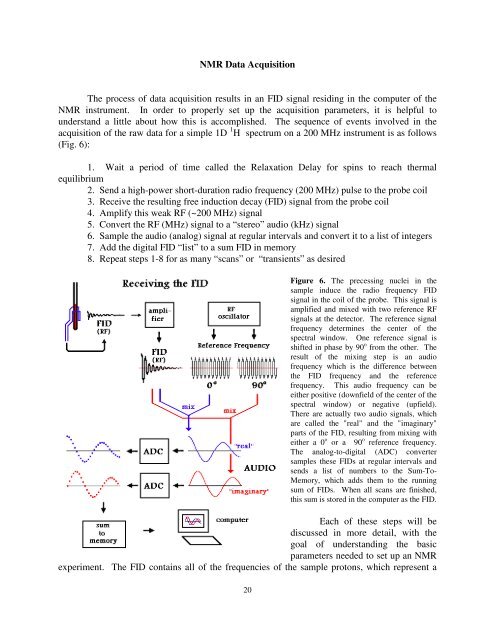
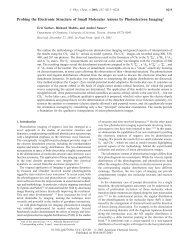
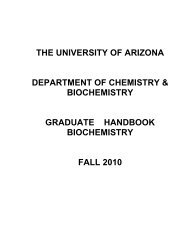
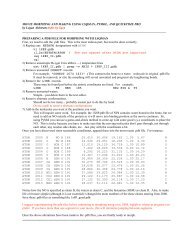


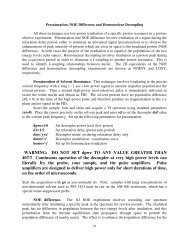


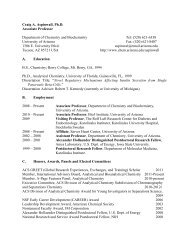
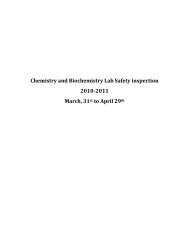
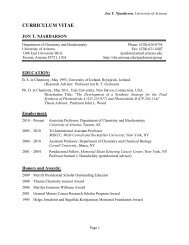
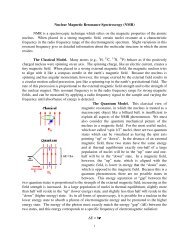
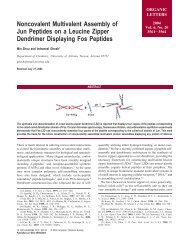
![Program [pdf] - Department of Biochemistry and Molecular ...](https://img.yumpu.com/8309921/1/167x260/program-pdf-department-of-biochemistry-and-molecular-.jpg?quality=85)